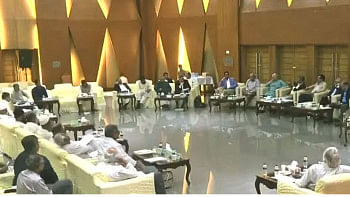Of homes and the worlds: Women, violence, and the domestic space

November 25, the International Day for the Elimination of Violence Against Women, marks the beginning of 16 Days of Activism against Gender-Based Violence which goes until December 10, Human Rights Day. Here at DS Books, we pondered long and hard over the kind of books that help us process, understand, and mull over the complex subject of gendered violence. GBV is a complex and layered issue and when done right, fictional accounts often lay bare the horrors and intricacies of the subject with nuance and care. For a country still reeling from the public violence of July unleashed upon its citizens and the renewed vigour with which its female citizens have been subjected to harassment and violence in recent months, it seemed, to us at least, urgent to turn inward—to the site of private gender-based violence. For every day, our newspapers report grisly tales of domestic violence, of homes being unsafe spaces for women and girls, of girls being forced to leave home, of a woman's perpetual search for a home that is her own. For these 16 days then, here is a list of novels and a short story that address the complex interplay of violence and empowerment in the domestic space and the ways in which women navigate its confining and often liberating potential.
For these 16 days then, here is a list of novels and a short story that address the complex interplay of violence and empowerment in the domestic space and the ways in which women navigate its confining and often liberating potential.
Subarnalata
Ashapurna Devi
Mitra & Ghosh Pvt Ltd., 1967
This novel follows the story of Subarnalata, a girl born into a middle-class Bengali family of the 20th century. As a daughter, Subarna is expected to remain confined to the domestic sphere, with limited freedom and autonomy. She is initially a naive and idealistic girl who dreams of a more independent life but as she grows up, she finds herself caught in the web of marital and maternal responsibilities, all the while grappling with her personal desires and aspirations. The novel traces Subarna's life unfolding in her domestic spaces—first, in her maternal home, and then, in her in-laws'.
While Subarna's domestic life represents limitations, it also becomes a site for her personal growth. Here, Subarna exhibits a rare show of agency, in questioning the restrictions placed upon her and on middle-class women as a whole, who are expected to be meek and domesticated. She reflects on how the women at her in-laws' are all happily confined within the four walls of the kitchen: "They don't know the taste of the open air, don't know how to read books, or remember prose", she thinks to herself. Later we see that she, too, dedicates her life to raising her daughter Bakul and taking care of the family. She never, however, loses her voice to the oppressive forces of patriarchy and fights to gain equal rights for her daughter, herself, and the women in her household, uplifting the place of women in society.
Subarnalata is a fascinating tale of equity because Ashapurna Devi shows, through Subarna, an intellectual and emotional evolution taking place in the context of domesticity while the character gradually seeks ways to carve out her own space within the family unit. This space is not always physical in the novel but is more about claiming an emotional and intellectual space for herself within the constraints of her environment.
The Bluest Eye
Toni Morrison
Holt, Rinehart and Winston, 1970
Early on in this classic tale about Black girlhood, racial self-loathing, and racial resistance, the novelist makes a distinction between being "put out" and being "outdoors". "Put out", for Morrison has some saving grace—here one goes somewhere else. But if one is "outdoors", one has no place to go back to. The child protagonist at the heart of the novel has been left outdoors by her father who has done the unfathomable and unspeakable twice: Raped his own child and left the family outdoors after burning down the home. For a black family, a home is what stands between having a life and not having one during the Great Depression-era Ohio. Morrison's depiction of the Breedlove's family home, a home reeking of neglect and joylessness, of broken furniture and memorylessness, of physical and psychical violence—further testifies to the link she draws among poverty, gendered violence, and the domestic space. That Pecola's mother painstakingly, adoringly cares for the white household where she works as a domestic worker and neglects her own home and children demonstrate that "home" in the novel is both a fantasy and a site of terror. The domestic landscape thus compels us to rethink socially-sanctioned ideals of domesticity particularly with regards to black girls and indeed, their mothers.
Nervous Conditions
Tsitsi Dangarembga,
The Women's Press, 1988
In his introduction to Franz Fanon's The Wretched of the Earth (François Maspero, 1961), Jean-Paul Sartre wrote that "The status of 'native' is a nervous condition introduced and maintained by the settler among colonised people with their consent." An exquisite study of gendered division of labour, race, coloniality and a coming-of-age, Dangerembga's novel is set in the 1960s postcolonial Rhodesia and follows Tambu, the female protagonist who at the opening of the novel is not unhappy to hear of her brother's passing. As the girl child who has so far been denied education and restricted to doing domestic chores, Tambu is pleased when her influential uncle decides she should replace her dead brother at the missionary school where he used to study. Thus begins Tambu's foray into spaces that has historically been made inaccessible to her. A product of the colonial encounter and bound by older notions of patriarchy as well as the changing socio-cultural norms of postcolonial ideals, the domestic space is a heavily contested site in the novel. On one hand, central female characters face extreme marginalisation in decision-making processes and experience sexual and gendered violence in homes. On the other, women such as Lucia and Maiguru challenge notions of sexual autonomy and female respectability.
Sultana's Dream
Rokeya Sakhawat Hossain
The Indian Ladies Magazine, 1905
Set in 20th century Bengal, Rokeya Sakhawat Hossain's seminal text, "Sultana's Dream", constructs an imagined community where women are not necessarily given, but rather demand and take access to power and education from the men who ruled before them. As a result of this flipping of the script, where men are subjugated and secluded to the zenana to which women where previously relegated, and women instead tend to the intellectual, administrative, and judicial matters of the land, "Sultana's Dream" is popularly hailed as a feminist techno-utopia. However, Hossain's Ladyland perhaps lends itself less to this utopian conceptualisation on account of it being a new world order built primarily along gendered lines; its subversions can default to gender essentialism, ultimately reproducing many of the same repressive structures it had sought to counter. Instead, through its satirical meditation on the occupation of domestic space and the world beyond, "Sultana's Dream" serves as a stark reminder of the absurdity of a society governed and rationalised on the basis of gender, pointing out and deconstructing misogynistic arguments popularly deployed against the empowerment of women and their participation in society.
Nazia Manzoor teaches English at North South University. She is also Editor, Star Books and Literature. Reach her at [email protected].
Maisha Syeda is a writer, painter, and lecturer at North South University.
Amreeta Lethe is a writer and translator, and sub-editor at Star Books and Literature.



 For all latest news, follow The Daily Star's Google News channel.
For all latest news, follow The Daily Star's Google News channel. 






Comments